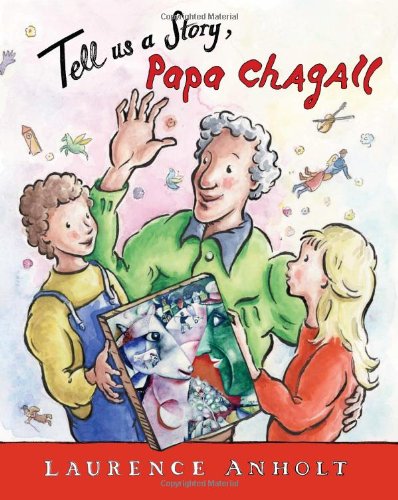Tell Us a Story, Papa Chagall
This is the latest in Anhalt’s series on the lives of great artists. His subject is the Jewish Russian painter, Marc Chagall, and Anholt lets Chagall himself tell his twin grandchildren his life story.
Chagall starts with his impoverished childhood in Russia and how a local art teacher was so impressed by his paintings that he taught him for free. Later, he tells how he met his wife and their move to Paris and the birth of a daughter, the twins’ mother. As the Second World War looms and the Nazis declare Jewish art ‘degenerate’, the Chagall family flee to America. Lastly, we see the family back in France, where Chagall became rich and famous.
What I particularly liked about this book is the way Anholt’s illustrations echo Chagall’s own style and colour palette. Chagall and the children enjoy the zany pictures with flying people and strange-coloured animals. It’s a pity Anholt doesn’t say that they were inspired by Yiddish folk-tales, but perhaps he feels that the pictures’ joie-de-vivre speaks for itself.
A number of Chagall’s actual pictures are carefully placed among Anholt’s own illustrations so that readers can see for themselves what his paintings are like. I think Tell Us a Story, Papa Chagall is a great way to give children a simple account of the main events of Chagall’s life and, at the same time, introduce them to his paintings.
Anholt also, subtly, illuminates the history of the period: peasant life in a Russian shtetl; the explosion of French art in the inter-war years when Chagall designed sets for Diaghilev; the coming of the Nazis; the flight to America where the traumatized Chagall could only paint burning houses and terrified people and, lastly, he touches on Chagall’s artistic legacy. Children of seven plus should enjoy this book. Highly recommended.
Elizabeth Hawksley
—————————————–
I loved Tell Us A Story, Papa Chagall. They are lucky children because Papa Chagall’s world is brightly coloured and dreamy, like a sweet shop. There are a lot of hidden things in the paintings and in the stories that you can only find if you let yourself imagine them – they sort of pop into your head after a while, like being hungry suddenly. My mum and I talked about Jewish folklore which was important to Chagall and makes the paintings so strange and bright. Afterwards, I spent some time looking at other paintings by Chagall to see if I could work out the stories behind them.
William Stockton, age 9










